Pholiota mushrooms grow around the country and often appear in huge, vast groupings that are extremely hard to miss. They’re a common find in forests as well as urban and suburban areas. Some are edible, some are questionable, and some are unknown.
There are currently hundreds of Pholiota species described from around the world, with around 100 (maybe more, maybe less) in the United States alone. The classification and DNA research on this group is still ongoing, and there is likely lots more work to be done to sort it all out.

The most common and easily recognizable Pholiota species, the shaggy scalycap, is often confused with the honey mushroom, so learning the differences is important if you intend to forage honies.
This guide covers the more common Pholiota species in North America. In many cases, it’s easy to figure out you’ve found a Pholiota species, but much more complicated to determine which one it is.
- Scientific Name: Pholiota
- Habitat: Living and dead trees, primarily
- Edibility: Varies by species

Jump to:
Pholiota Mushroom Identification
The Pholiota genus includes mushrooms with scaly, sticky, or dry caps. They usually grow on wood, at the bases of trees, or on decaying tree roots. Most of these mushrooms are saprobes that rot wood. The spores of these mushrooms are brown, light brown, or yellowish brown in color. Many species have noticeable partial veils that then leave a ring on their stems. Their gills are attached to the stem but do not run down it, or do only just slightly. The most commonly collected species are large mushrooms with scaly or slimy caps, like the shaggy scalycap.
However, these features may not always distinguish Pholiota mushrooms from similar-looking wood-rotting mushrooms with brown spore prints. There are even terrestrial species that decompose buried or burned wood or even grow from the ground. Microscopic features may need to be investigated to get a definitive identification.
If you want to do a deep dive into Pholiota species, the most comprehensive research is The North American Species of Pholiota Species from 1968 by Smith and Hessler. A study done on South Korean Pholiota is also interesting as it includes some of the same species as North America. There is also The Genus Pholiota in Central and Western Europe from 2001.

Primary Pholiota Features:
(notice how vague many of these are — this can be a tough group to positively ID, with the exception of several very distinguishable species.)
- Spores that are brown, light brown, or yellowish brown (never purple brown, never white)
- Most grow on wood or the bases of trees or decaying tree roots
- Many have prominent partial veils which turn into a ring or skirt on their stems
- Gills attached to the stem
- Cap color is yellowish or brownish
- Stem is generally the same color as the cap
- Usually found in fall or spring. However, in northern and montane regions they can also be found during summer. And, in warmer climates they are also found in winter.
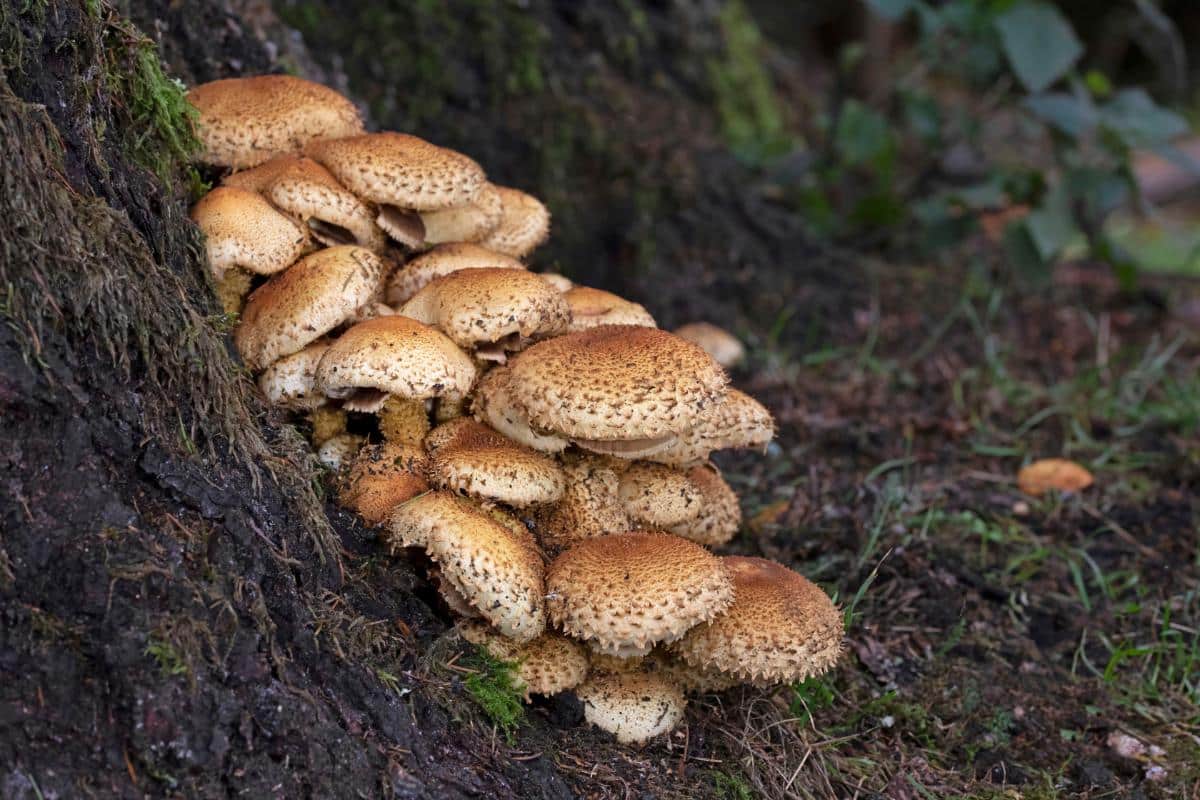


The Most Famous Pholiota Species
Pholiota nameko, commonly known as the Nameko mushroom, is an edible mushroom from East Asia. It does not grow native in North America but is widely cultivated here and around the world. It has been part of Japanese cuisine since the early 1800s. Nameko mushrooms originally grew in the wild on tree stumps and fallen logs, especially on Chinese hackberry and mulberry trees. The farming of Nameko mushrooms developed alongside shiitake mushroom farming in Japan. And, it’s popularity is just second to shiitake. As more people discovered Nameko mushrooms, farmers began to find ways to grow them artificially. By the early 20th century, commercial production of Nameko mushrooms became common.


Nameko mushrooms are valued for their unique texture and flavor. The cap is usually 1 to 2 inches wide and has a glossy, jelly-like surface that feels a bit slippery. This special texture and mild, nutty taste make Nameko a popular ingredient in many Japanese dishes. It is most commonly added to miso soup. Recently, interest in Nameko mushrooms has spread beyond East Asia, and farmers are now growing them in other parts of the world. Home cultivation kits are available for anyone who wants to grow Nameko mushrooms at home.

Common Pholiota Species in North America
Shaggy Scalycap (Pholiota squarrosa)
The shaggy scalycap or scaly pholiota cap measures between 1.5 to 4 inches in diameter. It starts out rounded but then flattens shape as it matures. Its most striking feature is the dense covering of yellowish-brown to rusty-brown scales that give the mushroom its shaggy appearance, hence its common name.
The stem is 2 to 6 inches in length and shares the same scaly texture as the cap, with scales arranged in a ring-like pattern below the partial veil. The gills are initially pale yellow but darken to a rusty brown as the spores mature. When fresh, these mushrooms often have a distinct odor that some describe as reminiscent of garlic, onions, or radishes.
It is commonly found growing in dense clusters at the base of hardwood trees, particularly oak, maple, and beech. This mushroom typically fruits from late summer through fall, though in milder climates, it may be found even into early winter.
The shaggy scalycap is not considered edible due to its bitter taste and potential to cause gastrointestinal distress in some individuals.
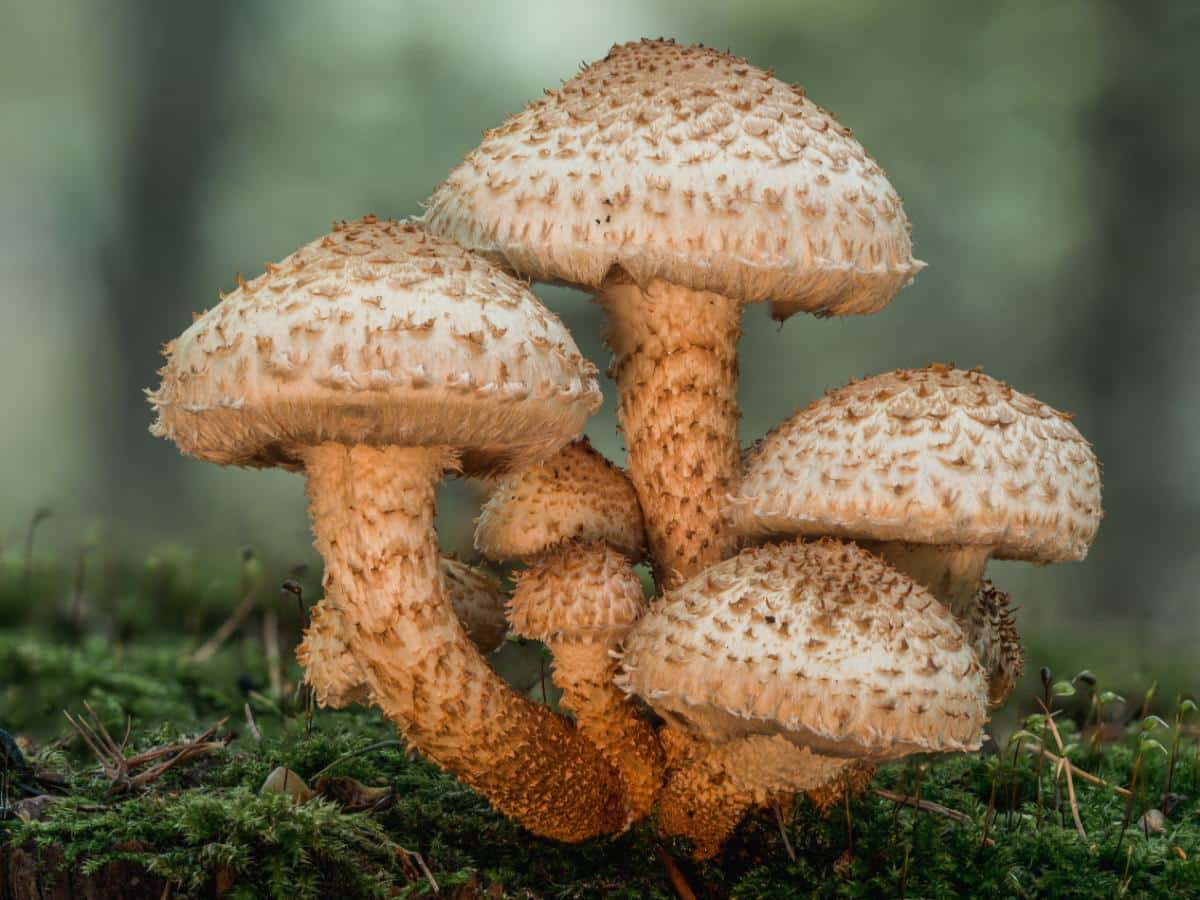
Pholiota squarrosoides
This species is so similar to the shaggy scaly cap that it is often impossible to tell them apart without microscopic analysis (under the microscope, the spores are much different). The primary differences are that P.squarrosoides has a sticky-ish cap and that it doesn’t ever smell like garlic or anything foul. In fact, it is said to have a fragrant smell.
However, since weather conditions can make a sticky cap turn dry, this tell-apart feature isn’t always reliable. And, because the shaggy scalycap doesn’t always smell strongly, this also can’t be used reliably to tell them apart.
The scales of P. squarrosoides are reddish brown. Usually, they aren’t quite as pronounced as on the shaggy scalycap, but this also can vary. Everything else about these two species is basically the same. They both grow in large clusters on hardwood trees and are widely distributed across North America.
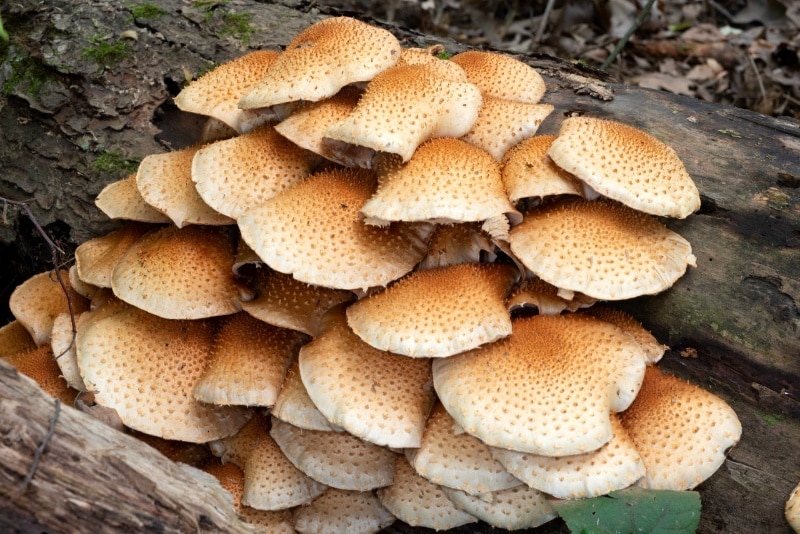
Pholiota squarrosoides by Dr. Lorne Stobbs on Mushroom Observer
Slimy scalycap (Pholiota adiposa species group)
Pholiota adiposa, also commonly known as the fatty Pholiota, has a distinctly slimy or greasy cap surface. This gives it a shiny, wet appearance. The cap is typically 1.5 to 4 inches in diameter and ranges from yellow to golden-brown in color. It has scattered reddish to brownish scales on it that are easily wiped off. The slimy scalycap feels slippery to the touch due to its glutinous coating.
The stem of P. adiposa is slimy, similar to the cap, with a ring that may be indistinct or absent. The slimy scalycap is found growing on hardwoods, particularly beech and alder. P. adiposa has a mild, sometimes slightly radish-like odor and a bitter taste. The slimy scalycap is widely consumed in China, where it is also commercially grown for consumption.
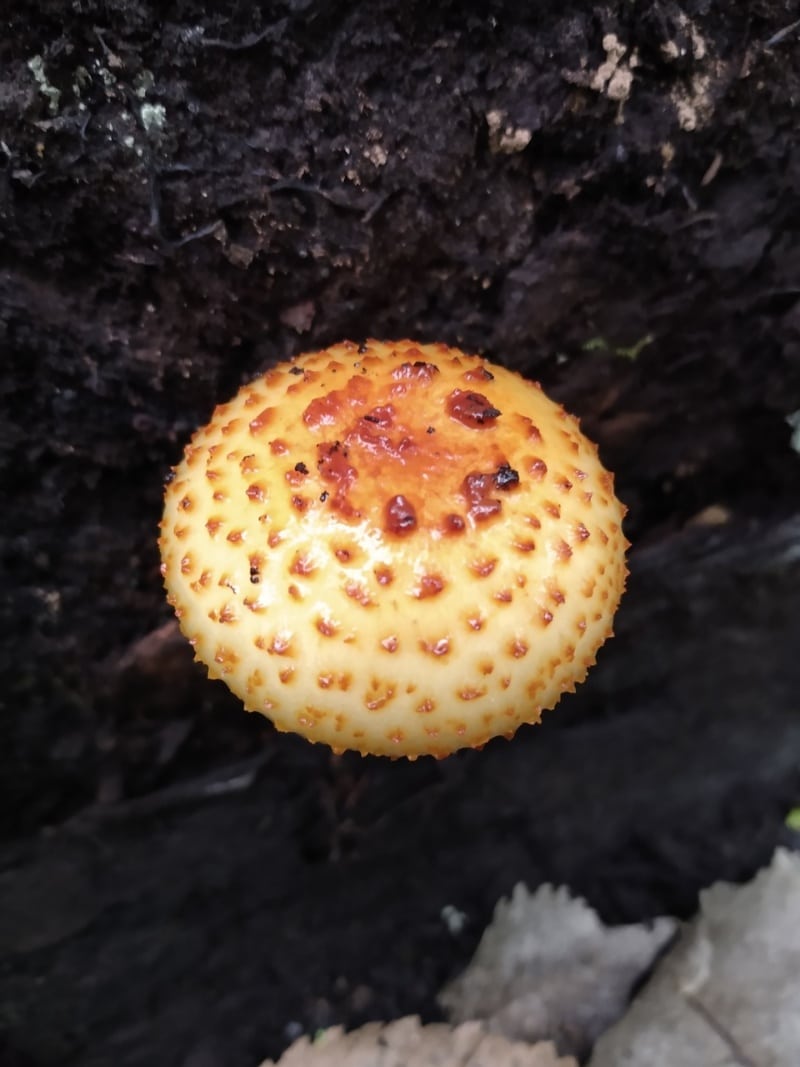
Pholiota adiposa by MCMUSH on Mushroom Observer
Hedgehog Pholiota (Flammulaster erinaceellus, previously Pholiota erinaceella)
The hedgehog Pholiota is a small mushroom, typically measuring between 0.4 to 1.2 inches (1-3 cm) in cap diameter. Its cap is rounded, often with a slight upraised center.
The most distinctive feature of Flammulaster erinaceellus is its densely hairy or bristly cap surface, which gives it a fuzzy appearance. These hairs are particularly noticeable on young specimens. The scales of this species are much smaller than those of the shaggy scalycap, and they often turn powdery with age.
Both species have decorated stems, but like with the cap, the texture of the scales is different. The hedgehog Pholiota is covered in fine hairs or small scales. This species grows across North America but is more common in the northeast.
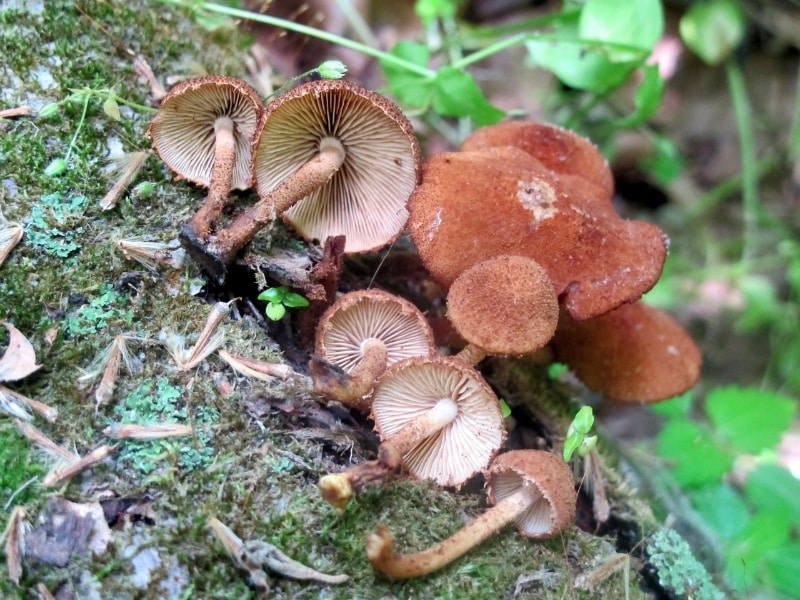
Flammulaster erinaceellus by walt sturgeon on Mushroom Observer
Flaming Pholiota (Pholiota flammans)
The cap of the flaming Pholiota typically measures 1-2 inches (2.5-5 cm) in diameter. It is known for its vibrant, flame-like appearance, with caps that are bright yellow to orange-yellow. The surface of the cap and stem are covered in small, erect scales that give it a striking, almost fuzzy texture.
The flaming Pholiota grows on coniferous wood, particularly in mountainous or northern regions. It often appears in smaller clusters or sometimes solitarily.
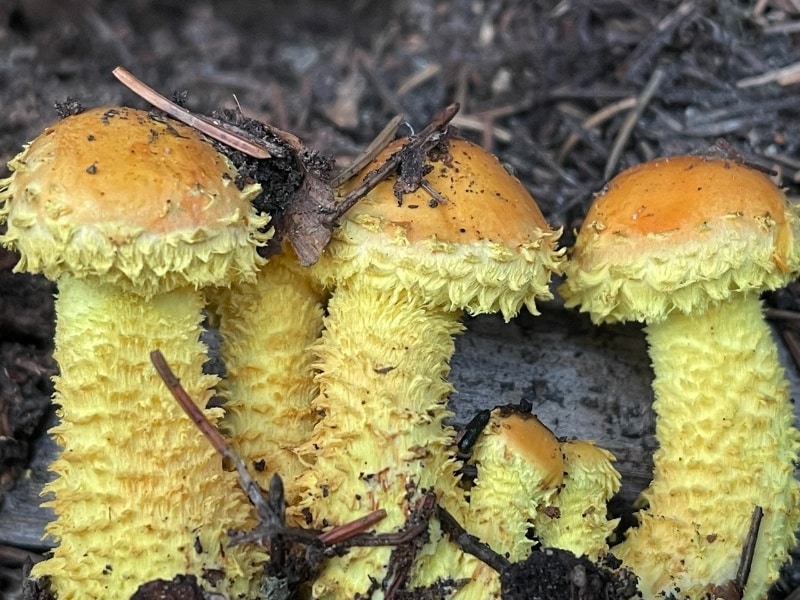
Pholiota flammans by Joe Mat on Mushroom Observer
Sheathed Woodtuft (Kuehneromyces mutabilis, previously Pholiota mutabilis)
The sheathed woodtuft has a cap that ranges from 1 to 3 inches in diameter. The cap color varies from honey-brown to reddish-brown, fading to a paler shade when dry. The cap does not have scales on it and is, instead, smooth.
The stem of the sheathed woodtuft is usually 2 to 4 inches long and has a distinct ring or collar. The stem is smooth above this ring but scaly below it. The scales are whitish or brownish and small. The sheathed woodtuft is most common in montane northern areas.
This species grows in clusters on decaying hardwood. The sheathed woodtuft is edible and is popular in some European cuisines, known for its mild, slightly nutty flavor. However, you must be very careful if you want to forage this species because it very closely resembles the Deadly Galerina.
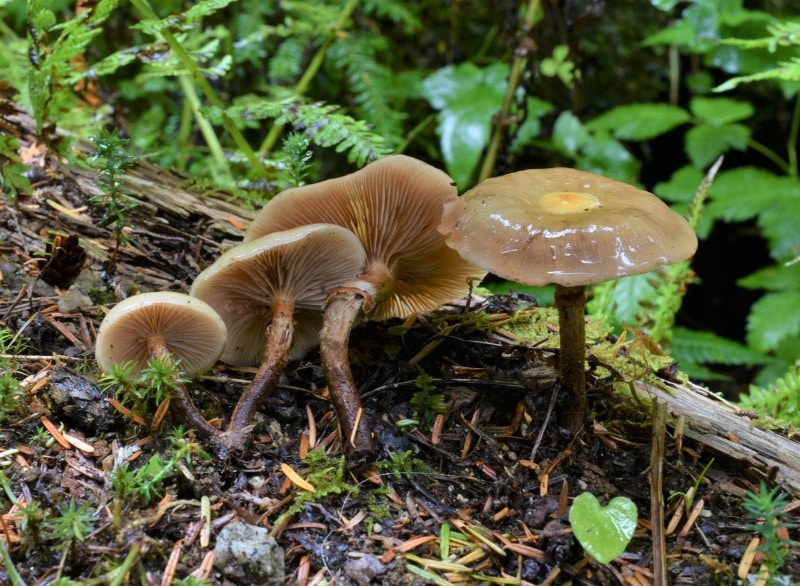
Kuehneromyces mutabilis by JMiller on Mushroom Observer
Variable Pholiota (Pholiota polychroa)
The variable pholiota cap measures 1 to 3 inches in diameter. Its cap color can vary significantly, ranging from yellowish-brown to reddish-brown or even purplish-brown, hence its common name. The surface of the cap is slimy and covered with small, fibrillose scales that are often darker than the background color. With age, the scales usually fall off completely.
The stem of the variable Pholiota is usually 2 to 4 inches long and typically the same color as the cap or a little lighter, with fine scales or fibrils. This species is typically found growing on hardwood logs, stumps, and occasionally on living trees. It often grows in small clusters or scattered groups. The variable Pholiota appears east of the Rocky Mountains and may be more common in the southeast.
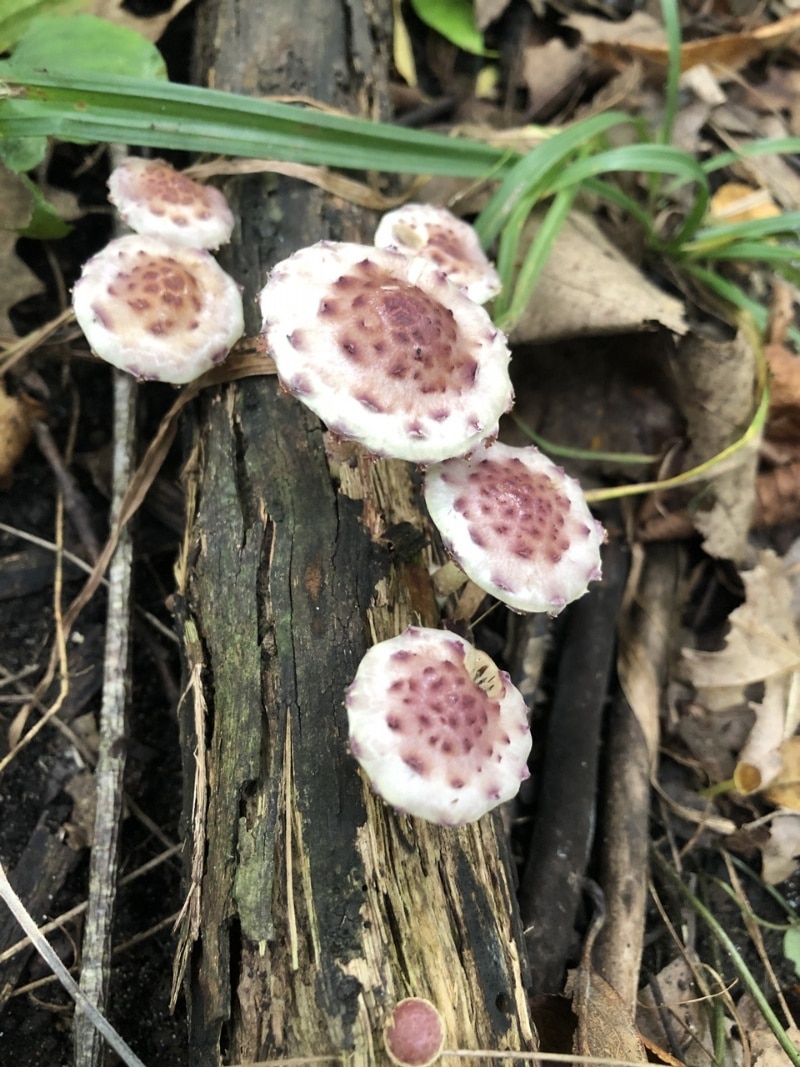
Pholiota polychroa by Philip Moore on Mushroom Observer
Destructive Philota (Hemipholiota populnea, formerly Pholiota destruens or Pholiota populnea)
Hemipholiota populnea, as its name suggests, is primarily associated with poplar (cottonwood) trees. It’s commonly found growing on the trunks or stumps of various poplar species, particularly in urban or suburban areas.
The cap of Hemipholiota populnea typically measures 2 to 6 inches in diameter. It starts rounded and flattens with age. The surface is dry and covered with small, flat scales that are more concentrated towards the center, giving it a somewhat fibrous appearance. The color ranges from pale yellow to ochre or light brown.
The stem of the destructive Pholiota is typically 2 to 4 inches long, solid, fibrous, and often curved, especially when growing from the side of a tree. The stem surface is smooth above the ring and scaly below, similar to the cap. The thin, fragile ring often disappears as the mushroom matures. The flesh of Hemipholiota populnea is white to pale yellow and has a mild, slightly sweet odor.
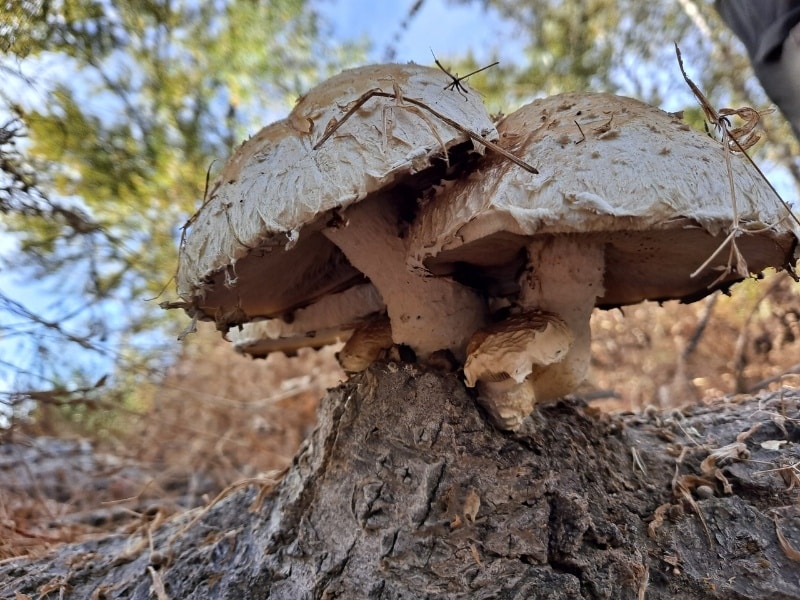
Hemipholiota populnea by Jacob on Mushroom Observer
Pholiota terrestris
As its name suggests, Pholiota terrestris is typically found growing on the ground. This is rare for a Pholiota species. It is often in grassy areas or in soil rich with woody debris. This species has a cap that ranges from 1 to 3 inches in diameter, with a rounded to flattened shape. It has a dry, scaly surface that is typically brown to reddish-brown in color. The scales are small and often wear off with age.
The stem has the same brown scales as the cap, and they appear below the ring zone. The stem is also notably longer than the length of the cap, giving it a leggy appearance. Around the upper stem is a thin, fragile ring that often disappears as the mushroom matures. It typically has a mild, slightly radish-like odor and a bitter taste.
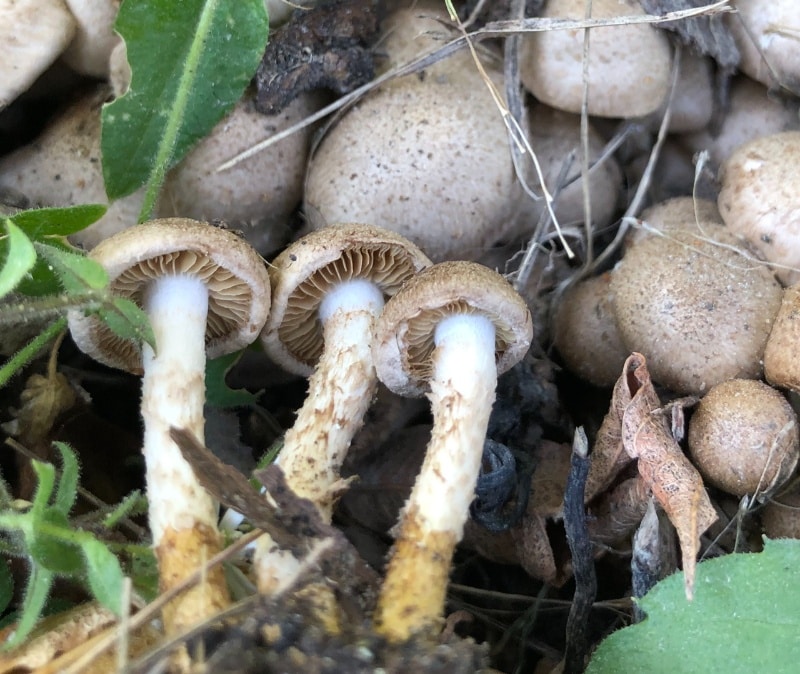
Pholiota terrestris by purplecloud on Mushroom Observer
Golden Scalycap (Pholiota aurivella)
*Pholiota limonella is virtually identical to Pholiota aurivella; the only difference is spore size. You can use this physical description for both species.
The cap of the golden scalycap measures between 2 to 6 inches in diameter and has a rounded to flat shape, often with a slightly raised center. The cap’s surface is covered with golden-yellow to rusty-brown scales. These scales are more concentrated towards the center and become sparser towards the edges, creating a gradient effect.
The stem is usually 2 to 4 inches long and can be slightly curved, especially when growing in clusters. The stem’s color ranges from pale yellow to light brown. It often has a ring or remnants of a partial veil near the top. Below the ring, the stem is covered in small, fibrillose scales that match the cap’s color.
The gills are initially pale yellow and gradually darkening to a rusty brown. The flesh of the golden scalycap is firm and pale yellow, with a mild taste and a slightly radish-like odor. This species is most common in the Southwest.
While some consider the golden scalycap edible, it’s not widely consumed due to its bitter taste and the potential for confusion with other similar-looking species.
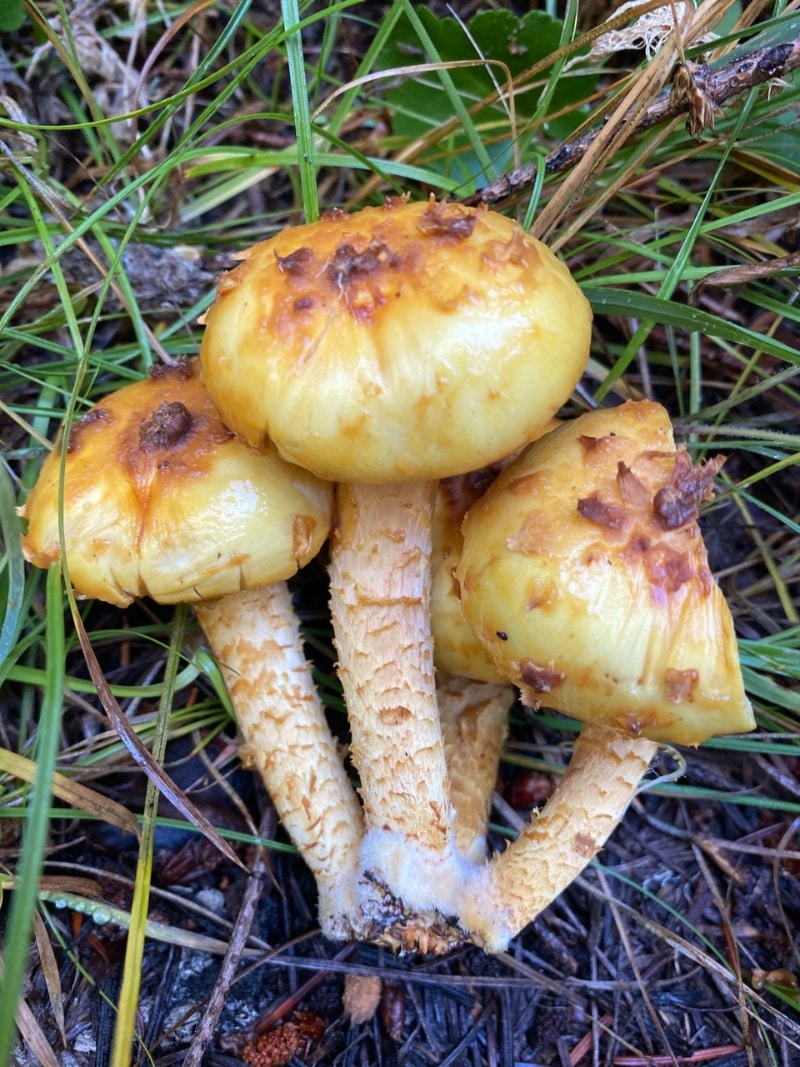
Pholiota aurivella by Bethany McKenzie on Mushroom Observer
Pholiota Mushroom Lookalikes
Decorated Pholiota (Leucopholiota decorosa)
This isn’t a real Pholiota and never has been, but it looks so much like one that its common name includes the Pholiota designation. The genus name Leucopholiota actually means “white Pholiota,” referring to the gills and the spores, which are white, in contrast to Pholiota’s brown ones.
Leucopholiota decorosa is generally smaller, with caps typically measuring 1-3 inches in diameter. Its cap is rounded, often with a slight umbo (raised center). The cap is covered in small, delicate, brown to rusty brown scales or hairs that give it a decorative appearance, hence its species name “decorosa.” Leucopholiota decorosa has a whitish to pale yellowish overall color, with the scales being slightly darker than the cap background.
The gills are white and attached to the stem with a small notch. The stem of Leucopholiota decorosa is usually 1.5-3 inches long, with fine fibrous scales or hairs similar to those on the cap. The mushroom produces a white spore print, which is a key identifying feature.
Leucopholiota decorosa is typically found growing on decaying hardwood, often on fallen logs or stumps. It’s less common and has a more restricted distribution. It is most common in eastern North America.
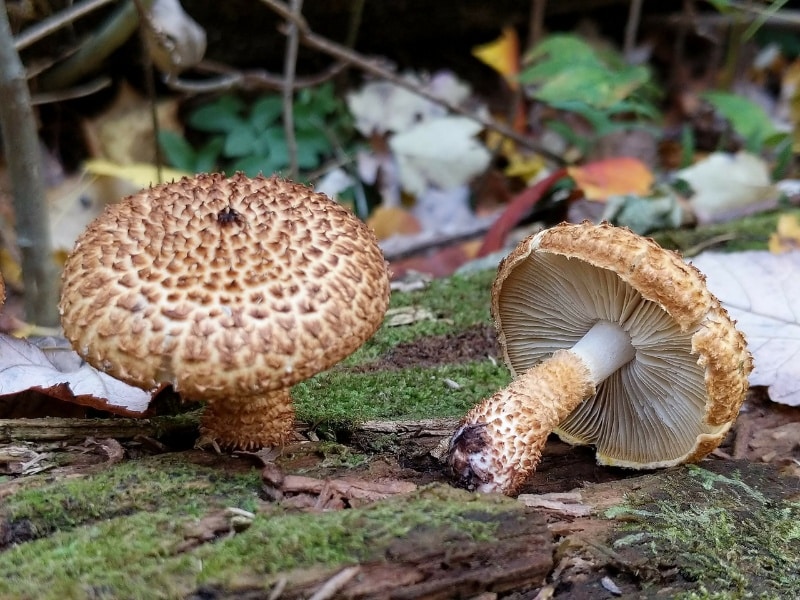
Leucopholiota decorosa by Crystal on Mushroom Observer
Honey Mushrooms (Armillaria mellea)
Armillaria mellea and Pholiota are both wood-decaying fungi that can be found growing on trees. They both form large, dense clusters that often cover an entire tree. While they share some similarities, these two species have several key differences.
Armillaria mellea typically has a honey-colored cap that ranges from 2 to 6 inches in diameter. Its surface is usually smooth or slightly scaly and is rounded when young. It flattens out with age. The gills are white and might turn pinkish-yellow with age. The honey mushroom has a slender stem, typically 2 to 8 inches tall, and has a prominent ring or collar near the top. The surface of the stem is covered lightly in gray fibers.
The spore print is white. If there is ever doubt, do a spore print. Honey mushrooms have white spore prints, while Pholiota species have brown spore sprints.
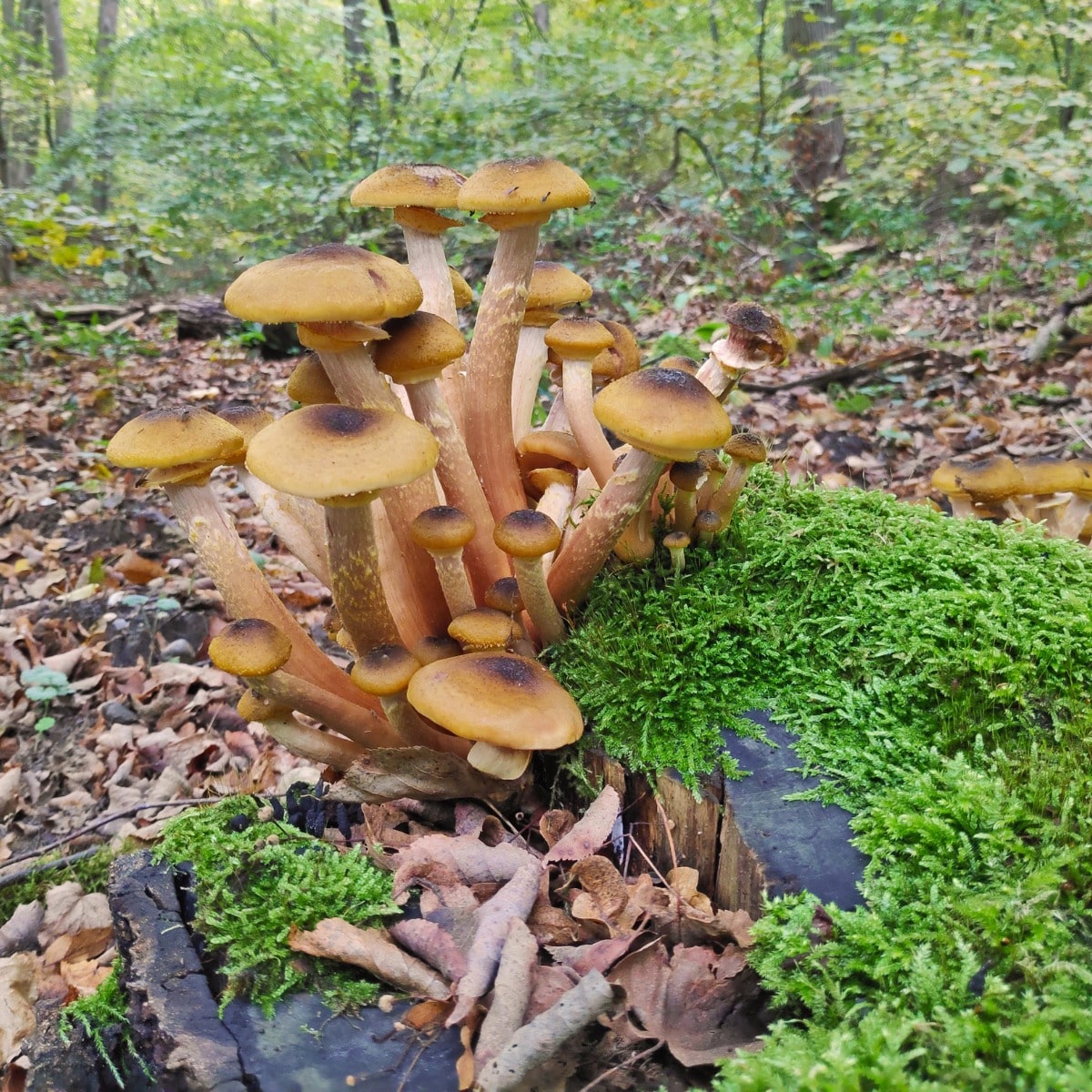
Medicinal Properties of Pholiota Mushrooms
Pholiota mushrooms have garnered attention in the scientific community for their potential medicinal properties. Several species within this group have demonstrated promising health benefits.
Pholiota adiposa has been the focus of recent research because it contains many beneficial substances. These include polysaccharides, proteins, vitamins, and sterols. Studies have found that extracts from P. adiposa have significant anti-tumor properties. The mushroom’s fruit body can inhibit tumor growth and promote programmed cell death in cancer cells. It may also be beneficial in treating AIDS.
Research suggests that this mushroom may also have anti-inflammatory properties and could regulate the gut microbiota. In a study with mice, P. adiposa extract reduced tumor size and improved the balance of intestinal microorganisms in those with liver cancer. This indicates that the mushroom may positively affect cancer progression and gut health.
Another interesting species in the Pholiota genus is Pholiota squarrosa, which produces a protein called PhoSL. This protein has shown great potential in fighting viral infections, especially SARS-CoV-2.

Common Questions About Pholiota Mushrooms
Are Pholiota mushrooms edible?
It depends on the species. Some Pholiota species are edible, while others are not.
What is the difference between Pholiota and Armillaria?
Many Pholiota species resemble the edible and widely foraged honey mushroom (Armillaria species). The most effective method to tell these species apart is by doing a spore print. Pholiota species have brownish spore prints while honey mushrooms have white spore prints.

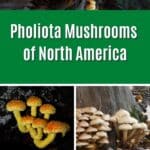
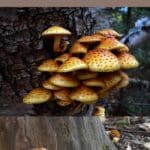
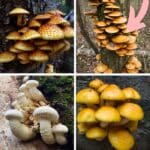
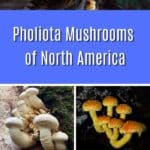
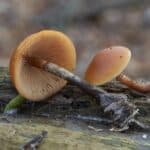
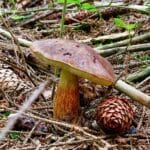
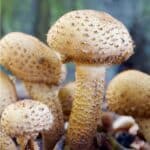
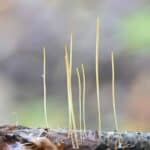
Leave a Reply